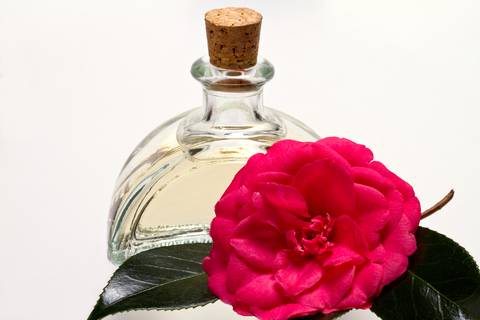Both camellia (tea) oil and olive oil have unique properties that make them the best for some applications, but not for others. So, if someone were to hold a gun to my head and make me choose between these two oils, I’d probably end up dead.
Improve Memory and Concentration with AromatherapyBoth camellia oil and olive oil are edible oils, but camellia oil has a much higher flashpoint than olive oil which makes it a bit better cooking oil for frying.
Olive oil contains roughly 80% monounsaturated, 14% saturated, 9% polyunsaturated fats and vitamins A, B-1, B-2, C, E and K. It also contains iron. Olive oil is rich in polyphenols (antioxidants).
Camellia oil is high in oleic acid, a mono-unsaturated oemga-3 fatty acid and naturally contains other essential fatty acids, such as omega-6 and linoleic acids. It also contains and vitamins A, B, C, E and minerals. Camellia oil is also rich in polyphenols.
Olive oil is much heavier oil than camellia oil. Camellia oil absorbs very quickly into the skin with no oily residue whereas olive oil can hang around for awhile. Also, olive oil carries that infamous salad dressing aroma as compared to the light delicate fragrance of camellia oil.
Camellia oil uses:
- Improves skin elasticity
- Nourishes skin
- Hydrates skin making it ideal as body oil
- Anti-inflammatory
- Reduces and heals scars
- Improves complexion
- Softens wrinkles and fine lines – used in anti-aging creams and lotions
- Non-comedogenic (Suitable for oily and acne prone skin)
- Non-allergenic and suitable for all skin types
- Used in hair care products such as shampoos and rinses
- Shelf life 2 years
Olive oil uses:
- Protects skin from sun damage – anti-carcinogenic
- Moisturizes skin
- Nourishes skin
- Skin rejuvenator
- Anti-inflammatory
- Anti-aging
- Improves skin elasticity
- Helps to heal scars
- Shelf life 2 years
As you can see, both of these oils are just absolutely super performers. In fact, camellia oil is often referred to as the olive oil of the orient. Since no one is actually holding a gun to my head and forcing me to choose, I choose to have both olive oil and camellia oil sitting on my shelf.
I make my skin and hair care products such as creams, lotions and shampoos using camellia oil because it is so light and readily absorbed into my skin. It also has a much lighter aroma than olive oil. However, if I were creating a skin care cream or lotion where I wanted more protection from solar rays, I would use olive oil.
For cooking, I use both oils. For more delicately flavored dishes, I use camellia oil. For others and general frying, I use olive oil. That’s me. How about you? Let’s hear about your experiences using camellia oil. Comment below, we’re very interested in what you have to say.
Now go have fun and relax.
Related articles:


I would like to make my own camellia oil. Is it the same process as making calendula oil by soaking in a carrier oil over a couple of weeks then repeating the process. Then heat and add grated bees wax
Camellia oil is produced by cold pressing the seeds of C. Oleifera mainly, but also from C sinensis and C. japonica. If you have enough seeds from your plants, you can extract it with a mortar and pistil. The seeds contain somewhere between 40% to 50% oil.
You can also extract oil from leaves. The concentration of oils in the blossoms and leaves are in much lower concentrations. There are a number of extraction techniques which I won’t cover here.
You can infuse C. sinensis in a carrier oil by using high quality green tea.
Green tea is C. sinensis.
Hope this helps.